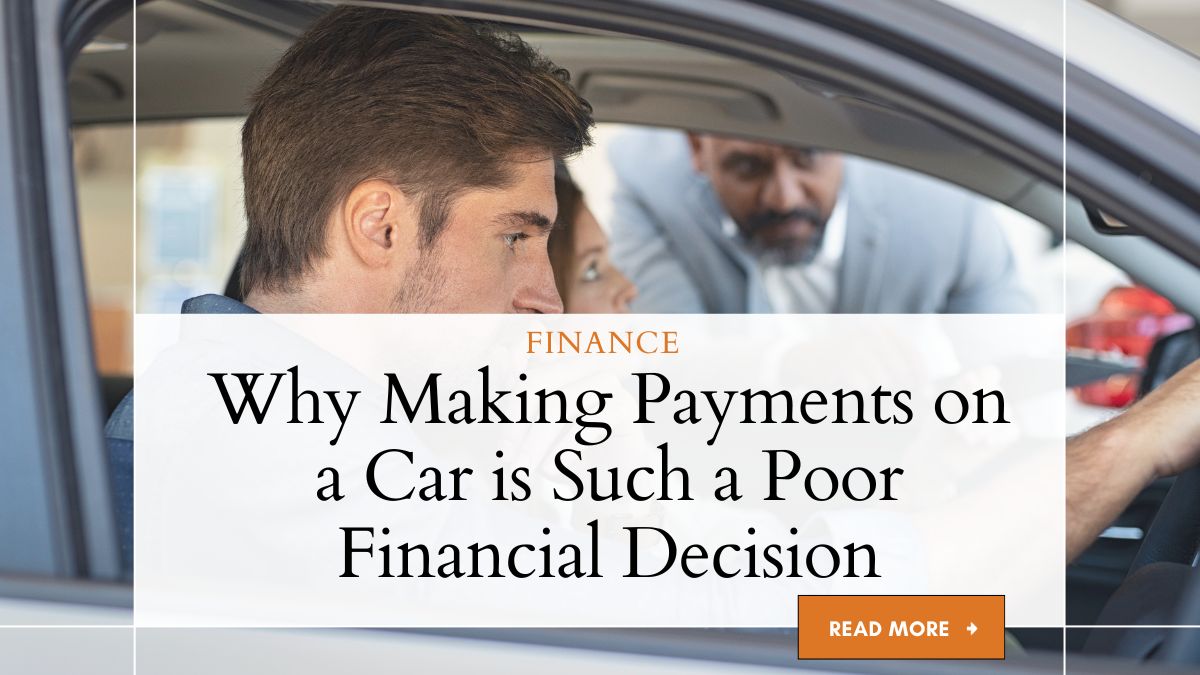
The excitement of driving a brand-new car off the lot is a feeling many of us aspire to experience.
The latest features, cutting-edge technology, and that unforgettable new car smell can make it seem like you’re not just buying a car, but also purchasing a ticket to a better life.
However, the reality is often far less glamorous, especially when you consider the financial implications of making payments on a car.
This article aims to explain why making payments on a car is such a poor financial decision.
We’ll explore the hidden costs, the cycle of debt, and the opportunity costs that could derail your financial future.
Before you commit to years of monthly payments, read on to understand the full scope of what that decision could mean for your financial health.
Also, you can able to know,
1. The Emotional Trap: Why We Fall for New Cars
In this section, we delve into the psychological factors that make new cars so alluring.
From the sensory experience of new car smells to the societal pressures that equate material possessions with success, we’ll explore how these emotional triggers can lead us into making poor financial decisions.
The Smell of New Leather: Emotional Marketing Tactics
The aroma of new leather is more than just a pleasant scent; it’s a psychological trigger meticulously crafted by marketers.
This olfactory experience is designed to evoke emotions of luxury, comfort, and sophistication, compelling you to make an impulsive buying decision.
It’s a classic example of emotional marketing, where sensory cues are used to bypass rational thought processes, leading you straight into a financial commitment that you may later regret.
Social Status: The Unspoken Pressure to Upgrade
In a society where material possessions often serve as yardsticks for success, the pressure to own a new or luxurious car can be overwhelming.
This unspoken societal pressure can make you feel obligated to upgrade, even when your current vehicle serves its purpose just fine.
The desire for social validation can drive you into a long-term financial commitment that offers no real value beyond superficial social approval.
Instant Gratification Vs. Long-Term Consequences
The immediate joy and satisfaction derived from acquiring a new car often overshadow the long-term financial implications.
It’s a classic case of instant gratification triumphing over rational decision-making.
While the dopamine rush of a new purchase is undeniable, it’s essential to consider the long-term consequences.
These can range from crippling debt and financial instability to missed opportunities for more valuable investments.
2. The Real Cost of Car Payments
Here, we’ll dissect the financial intricacies of car payments. Most people focus solely on the monthly payments, overlooking other significant costs like interest rates and hidden fees.
This section aims to unveil these hidden costs and show you the real price of that new car smell.
Interest Rates: The Silent Money Drainer
Interest rates may appear inconspicuous, often disguised as a small percentage that seems manageable.
However, over the life of a car loan, these rates can accumulate into a staggering amount.
For example, a 5% interest rate on a $30,000 loan can balloon into thousands of dollars over several years.
This silent money drainer siphons off your hard-earned income, leaving you with less financial flexibility for other essential aspects of life.
Depreciation: The Value You Lose as Soon as You Drive Off
The concept of depreciation is well-known, but its impact is often underestimated.
The moment you drive your new car off the dealership lot, its value can plummet by as much as 20-30%.
This isn’t just a theoretical loss; it’s a tangible hit to your financial assets.
If you decide to sell the car a few years down the line, you’ll likely recoup only a fraction of what you initially paid, making it a poor investment by any standard.
Hidden Fees: Taxes, Insurance, and More
Beyond the sticker price and interest rates, there are numerous hidden fees that can inflate your monthly payments.
These can include registration fees, taxes, and increased insurance premiums, among others.
These clandestine costs are often glossed over during the purchasing process, leaving you with a financial burden that exceeds your initial calculations.
It’s crucial to factor in these hidden fees when considering the true cost of buying a new car on loan.
3. Opportunity Cost: What You Could Have Done with That Money
In this segment, we shift our focus to the concept of opportunity cost.
We’ll discuss how the money spent on car payments could have been better utilized, whether by investing in appreciating assets or by building a financial safety net for emergencies.
Investing in Assets: How Your Money Could Grow Instead
The concept of opportunity cost is pivotal in financial planning.
Every dollar spent on car payments is a dollar that could have been invested in assets that appreciate over time, such as stocks, bonds, or real estate.
For instance, if you divert $400 per month away from car payments into a diversified investment portfolio with an average annual return of 7%, you could accumulate a substantial sum over a decade.
This missed opportunity for compound growth is a financial setback that could haunt you for years to come.
Emergency Funds: The Safety Net You’re Missing Out On
An emergency fund serves as a financial lifebuoy, providing a safety net for unexpected life events like medical emergencies or job loss.
By allocating a significant portion of your income to car payments, you’re essentially compromising your financial security.
Without a robust emergency fund, you’re just one unexpected event away from financial turmoil, making it a precarious position to be in.
Life Goals: Vacations, Home Ownership, and Financial Freedom
Life is not just about surviving; it’s about thriving. Dreams of taking exotic vacations, owning a home, or achieving financial freedom are often deferred or forsaken when you’re burdened with hefty car payments.
These life-enhancing experiences and assets bring not just immediate joy but long-term value, both emotionally and financially.
By prioritizing car payments, you’re essentially trading these invaluable life goals for a depreciating asset.
4. The Debt Cycle: How Car Payments Keep You Stuck
This section delves into the vicious cycle of debt that car payments can lead to.
From rolling over existing debt into new loans to the impact on your credit score, we’ll explore how car payments can become a financial quagmire that’s hard to escape.
Rolling Over Debt: The Domino Effect of Financing
It’s not uncommon for people to trade in their cars before they’ve even paid off their existing loans, rolling the remaining debt into a new loan.
This creates a pernicious cycle of indebtedness that can be incredibly challenging to break free from.
Each time you roll over debt, you’re not just taking on a new financial burden; you’re also carrying the baggage of your past financial decisions, making it a never-ending loop of financial obligations.
Credit Score Impact: The Unseen Consequences on Your Financial Health
Your credit score is a vital aspect of your financial health, affecting everything from your ability to rent an apartment to the interest rates on future loans.
Consistent late payments or defaults on your car loan can severely impact your credit score, making it more difficult to secure financial products or loans in the future.
This can have a ripple effect on other life goals, such as buying a home or starting a business, further entrenching you in a cycle of financial instability.
The Stress Factor: Emotional Toll of Being in Constant Debt
The emotional and psychological toll of being in perpetual debt can be debilitating.
The constant stress of meeting monthly payments, coupled with the fear of repossession, can lead to a range of mental health issues, including anxiety and depression.
This emotional burden often goes unnoticed but is a significant hidden cost of being ensnared in the cycle of car payments.
5. The Alternatives: Smarter Ways to Own a Car
Here, we’ll explore alternative approaches to car ownership that can save you money without compromising on mobility.
From buying used cars to considering car-sharing services, this section offers practical solutions for those looking to break free from the cycle of car payments.
Buying Used: Let Someone Else Take the Depreciation Hit
Purchasing a pre-owned car is a financially astute decision that allows you to sidestep the steep depreciation curve associated with new cars.
A used car that’s just a few years old can offer nearly the same utility and features at a fraction of the cost.
By letting someone else absorb the initial depreciation hit, you’re getting more value for your money, freeing up funds for other financial goals or investments.
Car Sharing and Public Transport: Not as Bad as You Think
In an age of burgeoning shared economy models, services like car-sharing platforms and robust public transport systems offer viable alternatives to car ownership.
These options not only save you money but also relieve you from the responsibilities and costs associated with maintenance, insurance, and parking.
For city dwellers or those with flexible transportation needs, these alternatives can be both convenient and financially prudent.
Saving Up: The Lost Art of Paying in Full
In a world driven by instant gratification, the concept of saving up for a significant purchase seems almost archaic.
However, paying for a car in full, upfront, can save you from the labyrinthine complexities of interest rates, hidden fees, and perpetual debt.
It’s a financial discipline that offers both immediate and long-term benefits, including the freedom from monthly payments and the ability to invest in appreciating assets.
6. The Math Doesn’t Lie: A Case Study
In this section, we’ll present a real-life case study to illustrate the financial pitfalls of car payments.
Through the story of John Doe, we’ll crunch the numbers to show you the shocking total cost of owning a car through financing, compared to smarter alternatives.
Real-life Scenario: John Doe’s Financial Journey with Car Payments
Meet John Doe, an average American who decided to finance a new car with a five-year loan.
Over the course of those years, John ended up paying an additional $8,000 in interest alone, not to mention the depreciation hit he took when he eventually sold the car.
This sobering tale underscores the pitfalls of car payments and serves as a cautionary example for anyone considering this financial route.
Crunching the Numbers: The Shocking Total Cost
When you add up the various components—interest, fees, and depreciation the total cost of owning a new car can be staggering.
In John’s case, the total expenditure far exceeded the car’s initial sticker price, making it an eye-watering financial commitment.
The math doesn’t lie; the numbers reveal a harsh truth about the real cost of car payments, which often goes unnoticed until it’s too late.
Comparison: What John Could Have Done Differently
Had John opted for a used car or even public transport, he could have invested the difference in a retirement fund or an appreciating asset like real estate.
The potential for financial growth in these alternative scenarios is significant, highlighting the missed opportunities that come with the territory of car payments.
7. Common Myths Debunked
This segment aims to debunk some of the most common myths surrounding car payments and ownership.
From the misconception that cars are investments to the flawed logic that equates affordability with the ability to make monthly payments, we’ll set the record straight.
It’s an Investment: Why a Car is a Liability, Not an Asset
One of the most pervasive myths is that a car is an investment. The reality is far from it. Cars are depreciating assets that lose value over time.
Unlike investments, which have the potential for appreciation and income generation, cars are liabilities that drain your financial resources through depreciation, maintenance, and running costs.
I Can Afford the Monthly Payments: The Flaw in This Logic
Another common misconception is equating the ability to make monthly payments with affording the car.
This myopic view ignores the total cost of ownership, including maintenance, insurance, and the opportunity cost of not investing that money elsewhere.
Just because the monthly payments fit into your budget doesn’t mean you can truly afford the long-term financial commitment.
Leasing is Better: The Hidden Traps of Leasing a Car
Leasing appears to be a convenient alternative to buying, offering the allure of driving a new car every few years without the burden of ownership.
However, leasing comes with its own set of financial pitfalls, such as mileage restrictions, wear-and-tear charges, and the perpetual cycle of monthly payments.
In the long run, leasing is often more expensive than owning a car, especially if you consider the lack of asset ownership at the end of the lease term.
8. How to Break Free: Steps to Make a Change
In this section, we’ll provide actionable steps to help you break free from the financial burden of car payments.
From assessing your current financial situation to planning your exit strategy, this segment serves as a practical guide to achieving financial freedom.
Assess Your Situation: Taking a Hard Look at Your Finances
The first step toward financial freedom is a candid self-assessment. This involves scrutinizing your income, expenses, debts, and financial goals.
By painting a clear picture of your financial landscape, you can identify the areas where car payments are causing the most strain and devise a strategy to alleviate it.
Plan Your Exit: How to Get Out of Your Current Car Payment
Exiting a car loan is not easy, but it’s not impossible either. Options include selling the car to pay off the loan, refinancing to lower your interest rates, or using a windfall like a tax refund to make a significant payment.
Each of these strategies can help you extricate yourself from the quagmire of car payments and set you on the path to financial freedom.
Financial Planning: Setting Yourself Up for Success
Once you’ve broken free from the cycle of car payments, the next step is to establish a robust financial plan.
This should involve budgeting, saving, and investing in a manner that aligns with your financial goals and risk tolerance.
A well-crafted financial plan serves as your roadmap to financial freedom, providing a structured approach to wealth accumulation and financial security.
9. Testimonials: Stories of Financial Freedom
To wrap things up, we’ll share inspiring testimonials from individuals who have successfully escaped the financial trap of car payments.
Their stories serve as real-world evidence of the transformative power of making smart financial choices.
Sarah’s Story: From Car Payments to Investing in Real Estate
Sarah was once burdened by hefty car payments that left her financially strained. After selling her luxury car and opting for a more economical used vehicle, she used the savings to invest in real estate.
Today, Sarah enjoys a steady rental income and is on the path to financial independence, proving that smart financial choices can turn your life around.
Mike’s Journey: How He Traded His Luxury Car for Financial Peace
Mike was enamored with his high-maintenance luxury car until he realized the financial toll it was taking on him.
After trading it in for a more affordable model, he invested the difference in a diversified portfolio.
Now, Mike enjoys financial peace of mind, free from the stress of exorbitant car payments and maintenance costs.
Emily’s Transformation: How She Paid Off Debt and Traveled the World
Emily made the bold decision to ditch her car altogether and rely on public transportation and car-sharing services.
The money she saved allowed her to pay off her debts and even take a year off to travel the world.
Her story is a testament to the transformative power of financial freedom and the doors it can open.
Don’t miss: How to Become Rich and Famous Overnight
The bottom line
As we navigate through the complexities of personal finance, it’s essential to make informed decisions that align with our long-term goals.
The allure of a new car can cloud our judgment, leading us to underestimate the real costs and overestimate the benefits.
But as we’ve discussed, the financial ramifications extend far beyond the monthly payments and can have a lasting impact on your financial well-being.
From the insidious nature of interest rates to the missed opportunities for investing in appreciating assets, the downsides are numerous and significant.
While the immediate gratification of owning a new car may be tempting, the long-term financial consequences are often steep and unforgiving.
This article aimed to explain why making payments on a car is such a poor financial decision, shedding light on the hidden costs, the perpetuating cycle of debt, and the substantial opportunity costs.
As you stand on the precipice of making such a significant financial commitment, it’s crucial to consider these factors carefully.
Your future financial health may depend on the choices you make today.














